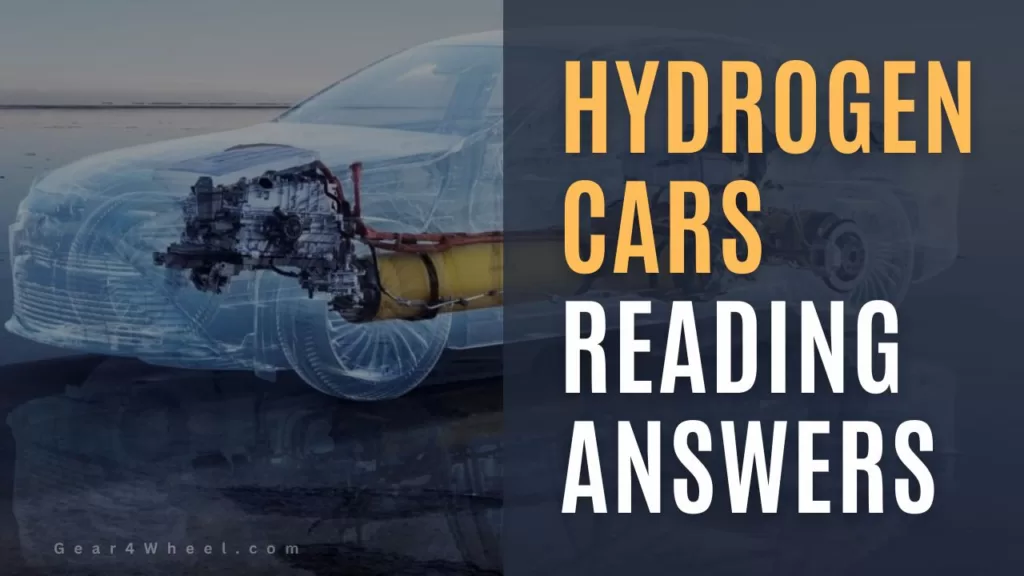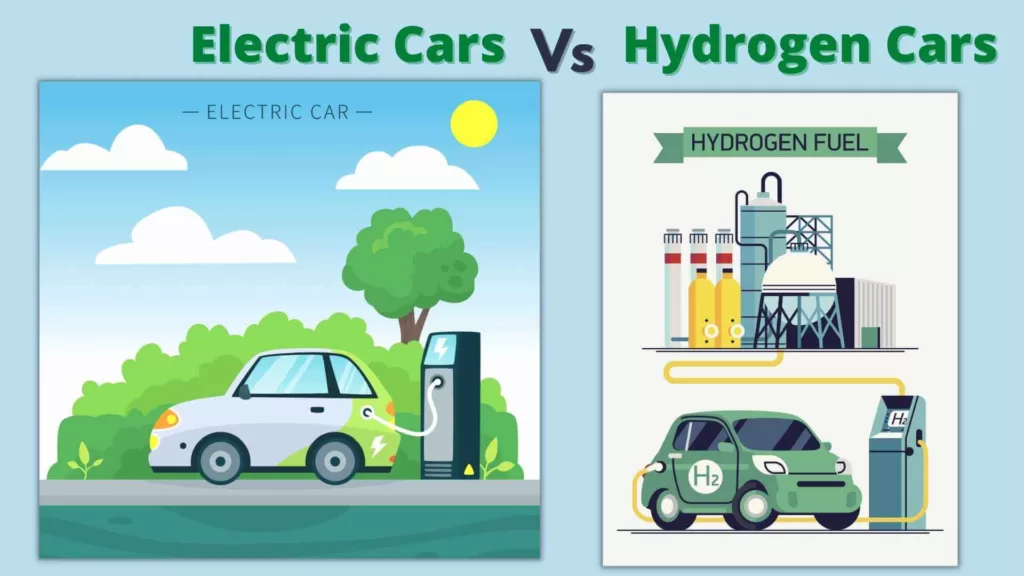
Hydrogen Cars Reading Answers
Hydrogen cars have been garnering attention as an innovative solution for clean transportation. If you’re curious about how these vehicles work, their advantages, drawbacks, and their potential impact on the environment, you’ve come to the right place. In this Q&A-style article, we’ll address some of the key questions you might have about hydrogen cars.
For detail understanding of hydrogen cars check our article Can Hydrogen Cars in India Shape India’s Future? | Available Cars
Hydrogen Cars Reading Answers: Q&A
1. How does a hydrogen fuel cell work?
A hydrogen fuel cell is a device that converts the chemical energy of hydrogen and oxygen into electricity. This process involves the reaction of hydrogen with oxygen from the air, resulting in the production of water and electricity. It’s essentially the opposite of the electrolysis process that breaks down water into oxygen and hydrogen.
At its core, a hydrogen fuel cell consists of several key components: an anode (negative electrode), a cathode (positive electrode), an electrolyte, and a catalyst. These components work together to facilitate the conversion of hydrogen into electricity with minimal environmental impact.
Here’s a detailed breakdown of how a hydrogen fuel cell works:
- Hydrogen Supply: The process begins with a supply of hydrogen gas (H2). This hydrogen can be obtained from various sources, such as natural gas or water, through processes like steam reforming or electrolysis.
- Anode Reaction: The supplied hydrogen molecules are directed to the anode of the fuel cell. At the anode, a catalyst (typically made of platinum) facilitates a chemical reaction that splits the hydrogen molecules into positively charged hydrogen ions (protons) and negatively charged electrons. This process is known as oxidation or the “anode reaction”:
H2 → 2H+ + 2e-- Electrolyte: Between the anode and cathode, there’s an electrolyte—a specialized material that allows ions to move between the anode and cathode while preventing the mixing of gases. This separation ensures that the electrons must flow through an external circuit, creating an electric current, before rejoining the hydrogen ions on the cathode side.
- Cathode Reaction: On the cathode side, oxygen gas (usually obtained from the air) is supplied to the fuel cell. The cathode also contains a catalyst, often platinum, that facilitates the combination of oxygen, electrons from the external circuit, and hydrogen ions from the anode to form water. This process is called reduction or the “cathode reaction”:
2H+ + 2e- + 1/2 O2 → H2O- Electrical Current: The movement of electrons through the external circuit generates an electrical current that can be harnessed for various applications, such as powering an electric vehicle or providing electricity for buildings. The electrons flow from the anode to the cathode, creating a flow of electricity.
- Water Vapor: As a byproduct of the cathode reaction, water vapor (H2O) is produced. This water vapor is usually in the form of steam and is released into the atmosphere. Because the only byproduct of the hydrogen fuel cell’s operation is water, it is often considered an environmentally friendly energy source.
- Overall Reaction: The overall chemical reaction occurring in the fuel cell can be summarized as follows:
2H2 + O2 → 2H2O2. What are the advantages of hydrogen cars?
Hydrogen cars come with several advantages over traditional gasoline vehicles:
- Zero Emissions: Hydrogen cars emit no pollutants, making them true zero-emission vehicles, ideal for combating air quality and climate change issues.
- Impressive Range: These vehicles offer a longer driving range compared to their electric counterparts, making long-distance travel feasible.
- Quick Refueling: Hydrogen cars can be refueled in approximately 5 minutes, a convenience unmatched by electric vehicles.
- Quiet and Smooth Operation: Hydrogen cars provide a serene driving experience, with their quiet and smooth performance.
3. What are the disadvantages of hydrogen cars?
While hydrogen cars have their merits, there are also some downsides:
- Higher Costs: Hydrogen cars are currently more expensive than traditional gasoline vehicles.
- Lack of Refueling Infrastructure: The availability of hydrogen refueling stations is limited compared to the widespread availability of gasoline refueling stations.
- Safety Concerns: Given that hydrogen is a flammable gas, there’s a potential risk of explosion if not handled with care.
4. Where does the hydrogen for hydrogen cars come from?
Hydrogen for these vehicles can be sourced from various avenues:
- Water: Electrolysis is employed to extract hydrogen from water, ensuring a clean production process.
- Natural Gas: Steam reforming of natural gas yields hydrogen, though it’s important to address associated carbon emissions.
- Biomass: Gasification of biomass materials, such as wood, contributes to hydrogen production.
- Renewable Energy: Solar and wind power can drive water electrolysis, yielding hydrogen through sustainable means.
5. What is the future of hydrogen cars?
The future of hydrogen cars is a topic of intrigue. Overcoming challenges like high costs, limited infrastructure, and safety concerns is essential for mainstream adoption. However, promising potential exists, with substantial investments in research and development by governments and companies worldwide.
6. How does hydrogen compare to electricity as a fuel for cars?
Both hydrogen and electricity are clean fuel options, each with its advantages:
- Longer Range: Hydrogen cars offer a longer driving range compared to electric vehicles.
- Quick Refueling: Refueling hydrogen vehicles takes a mere 5 minutes, while electric vehicles require longer charging times.
- Challenges: Hydrogen’s higher cost and limited refueling infrastructure pose challenges to its widespread adoption.

7. What are the safety risks associated with hydrogen cars?
Hydrogen is indeed flammable, but modern hydrogen cars are designed with safety features to prevent explosions. These vehicles are no more dangerous than traditional gasoline cars when handled properly.
8. What are the environmental benefits of hydrogen cars?
Hydrogen cars produce no emissions, contributing to air pollution reduction and climate change mitigation. As they release only water vapor as a byproduct, they are environmentally friendly alternatives to conventional vehicles.
Here’s a list of some of the key environmental advantages of hydrogen cars:
- Zero Emissions: Hydrogen cars produce absolutely no tailpipe emissions. The only byproduct of the chemical reaction in the fuel cell is water vapor, which is released harmlessly into the atmosphere. This zero-emission feature helps reduce air pollution and greenhouse gas emissions.
- Air Quality Improvement: The absence of pollutants from hydrogen cars contributes to improved air quality in urban areas. This is particularly important for reducing respiratory diseases and health issues caused by traditional internal combustion engine vehicles that emit harmful gases and particulates.
- Mitigation of Climate Change: Since hydrogen cars do not release carbon dioxide (CO2) or other greenhouse gases during operation, their adoption can play a significant role in mitigating climate change. This is crucial for reducing the impacts of global warming and ensuring a sustainable future.
- Reduced Carbon Footprint: Hydrogen production can be sourced from renewable energy sources like wind, solar, or hydroelectric power. When hydrogen is produced using renewable energy, the carbon footprint associated with its production is minimal, making it a low-impact fuel source.
- Resource Efficiency: Hydrogen can be generated from a variety of sources, including water and biomass. This diversification of feedstocks reduces dependence on fossil fuels and contributes to a more efficient and sustainable use of natural resources.
- Alternative Energy Storage: Hydrogen has the potential to act as an energy carrier, allowing excess energy generated from renewable sources (such as solar and wind) to be stored and used later. This addresses the intermittency of renewable energy and helps ensure a stable energy supply.
- Versatile Applications: Hydrogen fuel cells are versatile and can be used beyond transportation. They can be integrated into various applications, including stationary power generation for homes, businesses, and remote locations. This versatility expands the potential for cleaner energy use.
- Encouraging Renewable Integration: Hydrogen cars can promote the use of renewable energy sources for hydrogen production. As the demand for hydrogen increases, so does the incentive to invest in renewable energy infrastructure, accelerating the transition to clean energy systems.
- Reduced Noise Pollution: Hydrogen cars are quieter than conventional internal combustion engine vehicles. This reduction in noise pollution is particularly beneficial for urban areas, contributing to quieter and more livable environments.
- Technological Innovation: The development and adoption of hydrogen cars drive innovation in fuel cell technology, renewable energy integration, and sustainable transportation solutions. This innovation can extend beyond vehicles to benefit various industries.
- Global Adoption Potential: Hydrogen cars can be part of a global effort to reduce greenhouse gas emissions and dependence on fossil fuels. Their environmental benefits can resonate across countries, contributing to international sustainability goals.
9. What are the challenges to the widespread adoption of hydrogen cars?
Several challenges hinder the widespread adoption of hydrogen cars:
- High Costs: Hydrogen production costs need to decrease to compete with cheaper gasoline and electricity.
- Refueling Infrastructure: Widespread availability of refueling stations must be established.
- Efficiency: Enhancing hydrogen car efficiency to match gasoline vehicles is crucial for consumer acceptance.
In Conclusion Hydrogen cars offer a glimpse into a future of cleaner transportation, but their widespread adoption faces hurdles that require innovative solutions. By addressing challenges related to cost, infrastructure, safety, and efficiency, these vehicles could become an integral part of the transportation landscape, contributing to a more sustainable future.
Frequently Asked Questions:
1. What are the different types of hydrogen cars?
Hydrogen cars come in two main types:
- Fuel Cell Electric Vehicles (FCEVs): These cars use hydrogen fuel cells to generate electricity for their electric motors. They offer a range of about 300-400 miles and can be refueled in around 5 minutes.
- Hybrid Fuel Cell Electric Vehicles (HFCVs): HFCVs combine a hydrogen fuel cell with a battery, providing an extended range and quicker refueling compared to pure electric vehicles.
2. How efficient are hydrogen cars?
The efficiency of hydrogen cars depends on the type and production method:
- FCEVs: Around 60% efficient.
- HFCVs: Up to 80% efficient.
For Derails : afdc.energy.gov(FCEVs), wawanesa(FCEVs)
3. What are the different ways to produce hydrogen?
Hydrogen can be produced through various methods:
- Steam Reforming of Natural Gas: This is the most common method, involving the reaction of natural gas with steam to produce hydrogen and carbon monoxide.
- Electrolysis of Water: Water is split into hydrogen and oxygen using electricity. This method is clean but expensive.
- Biomass Gasification: Biomass materials are converted into hydrogen and gases.
- Photolysis of Water: Sunlight is used to split water into hydrogen and oxygen, though this method is still in development.
4. What are the different ways to store hydrogen?
Hydrogen can be stored using:
- High-Pressure Tanks: Hydrogen is stored at pressures of 700-1000 bar.
- Liquid Hydrogen: Stored as a liquid at extremely low temperatures (-253°C), requiring specialized equipment.
5. What are the different challenges to the widespread adoption of hydrogen cars?
Several challenges hinder the mainstream adoption of hydrogen cars:
- High Costs: The production of hydrogen is expensive, making hydrogen cars pricier than traditional vehicles.
- Refueling Infrastructure: There are not enough hydrogen refueling stations, limiting convenience.
- Safety Concerns: Hydrogen is flammable, raising safety concerns.
- Efficiency: Hydrogen cars are not as efficient as gasoline vehicles.
6. What are the different benefits of hydrogen cars?
Hydrogen cars offer several benefits:
- Zero Emissions: They emit only water vapor, contributing to a cleaner environment.
- Long Range: Hydrogen cars can travel long distances on a single tank.
- Quick Refueling: Refueling takes minutes, similar to traditional gasoline cars.
- Quiet Operation: Hydrogen cars provide a quiet and smooth driving experience.
7. What is the future of hydrogen cars?
The future of hydrogen cars is promising, yet uncertain. While challenges like cost, infrastructure, and efficiency need to be addressed, substantial.






